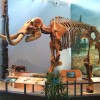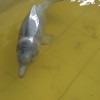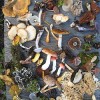
I was born in Mexico City where I did my undergraduate studies in Biomedical Research at the National Autonomous University of Mexico. During my last year of college I started teaching Biology and Human Anatomy and Physiology courses at “Logos” High school. I taught in this wonderful school for seven years and I can say with certitude that my experience working there was highly enriching. As a result, I decided to pursue a professional career where I could combine scientific research with teaching activities. While I was teaching and immediately after finishing college I studied a masters program in Urban Environmental Studies at “El Colegio de Mexico.” This gave me the opportunity to explore social aspects related to environmental sciences, such as economy, geography, public policy studies, and demography, among others. After finishing my master studies and working for three years in Mexico, I looked for a PhD program where I could combine my expertise in biological and social sciences in a conservation effort for protecting endangered species. Fortunately I found in the Ecology and Evolutionary Biology program at Columbia University the right curricula and faculty that supported the kind of research project I wanted to develop. I thus met Dr. George Amato, the director of the Sackler Institute for Comparative Genomics at the American Museum of Natural History (AMNH), who invited me to collaborate as a member of his research team. During my tenure at the museum, first as a graduate student and then as a postdoctoral fellow, I mentored and taught high school students participating in the Science Mentor Research Program, a National Science Foundation and AMNH initiative to promote science learning in New York City. Thanks to this collaboration, mainly with Dr. Hilleary Osheroff, the manager of this excellent program, I was notified about the working opportunity at the Dolan DNA Learning Center.
For me collaborating at the Dolan DNA Learning Center as the Urban Barcode Manager is a unique opportunity. Through this project I will be able to combine my expertise in scientific research and teaching for developing multidisciplinary projects related with environmental sciences and conservation biology. I will also be recruiting promising and talented teachers, scientist, and students that want to participate doing DNA barcoding projects in New York City. Therefore, this is an outstanding project where I can combine science research, outreach, and teaching activities.

In the 1970s a team of archaeologists led by Carl Gustafson unearthed the remains of a single, 3-ton, male mastodon (Mammut americanum, a close relative of mammoths and elephants), hunted and butchered by a group of men at the Manis site in the state of Washington, USA (Gustafson 1979). Among the mastodon remains they found a spear point that pierced a rib bone. Luckily for us the hunters did not recover the projectile weapon. We thus have evidence of the technology that cavemen in the Americas used to secure their food.
Originally Gustafson and his colleagues dated the mastodon hunting at More >

Could the meat in your plate pose a health risk for you? If the animal where it came from was properly raised and handled, and the meat went through a sanitary inspection before reaching your plate, there is little chance it can cause you a health problem. But, what could happen if a sanitary authority has not inspected it?
Your meat indeed could be a high risk for your health. In some cases this can be a public concern, because meat can be a source of pathogens that could cause a disease outbreak. In fact, it has been documented that close interaction More >

A few years ago there were four species of dolphins living in freshwater ecosystems or estuaries in the world. Two of them are still distributed in South America – the Amazon River and the Plata River dolphins (Inia gophrensis and Pontoporia blainvillei, respectively) – and two lived in Asia – the Ganges and Indus River dolphin (Platanista gangetica), and the Yangtze River Dolphin, or Baiji (Lipotes vexillifer). These species were highly adapted to live in freshwater ecosystems with distinctive anatomical characteristics that differentiated them from their marine relatives, such as larger snouts (almost four times larger than the snout size of More >

Documenting the biological diversity of our planet is a challenging task. It implies information collection and organization of millions of species, their genetic diversity and their interactions in biological communities and ecosystems. It also implies coordination among multiple institutions and thousands of scientists, environmentalists, and professionals working with biodiversity.
In 2007, Dr. Edward O. Wilson’s speech as the recipient of the TED Prize potentiated the creation of the Encyclopedia of Life (EOL), an international effort to gather together all human knowledge of Earth’s biodiversity. EOL’s mission is “to increase awareness and understanding of living nature through an encyclopedia that gathers, generates, More >

For several years scientists have tried to estimate the number of species living on Earth. This is not an easy question to answer and multiple approaches have been developed to calculate how large Earth’s biodiversity is. All of the estimates obtained so far have a large prediction range, hundreds of thousands or even millions of species from the smallest estimates to the largest ones. On top of this shaming ignorance, our planet’s biodiversity is highly threatened. Solid evidence indicates that we are facing a massive extinction event, driven unfortunately by our own activities. The most recent evidence indicates that a More >





